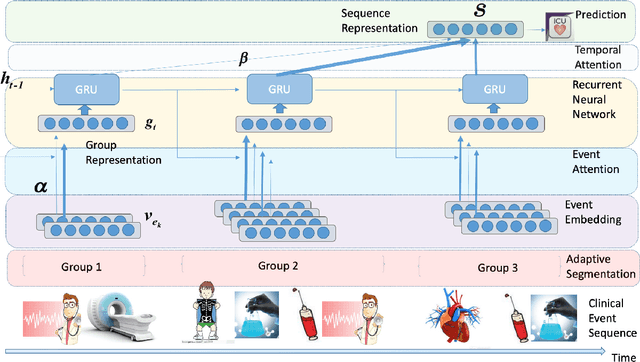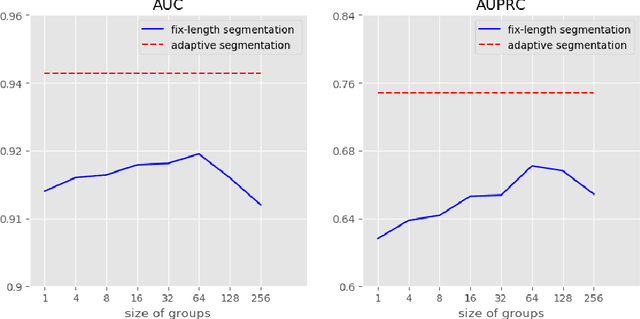Zichang Wang
Multi-task Learning via Adaptation to Similar Tasks for Mortality Prediction of Diverse Rare Diseases
May 11, 2020



Abstract:Mortality prediction of diverse rare diseases using electronic health record (EHR) data is a crucial task for intelligent healthcare. However, data insufficiency and the clinical diversity of rare diseases make it hard for directly training deep learning models on individual disease data or all the data from different diseases. Mortality prediction for these patients with different diseases can be viewed as a multi-task learning problem with insufficient data and large task number. But the tasks with little training data also make it hard to train task-specific modules in multi-task learning models. To address the challenges of data insufficiency and task diversity, we propose an initialization-sharing multi-task learning method (Ada-Sit) which learns the parameter initialization for fast adaptation to dynamically measured similar tasks. We use Ada-Sit to train long short-term memory networks (LSTM) based prediction models on longitudinal EHR data. And experimental results demonstrate that the proposed model is effective for mortality prediction of diverse rare diseases.
Predictive Multi-level Patient Representations from Electronic Health Records
Nov 12, 2019

Abstract:The advent of the Internet era has led to an explosive growth in the Electronic Health Records (EHR) in the past decades. The EHR data can be regarded as a collection of clinical events, including laboratory results, medication records, physiological indicators, etc, which can be used for clinical outcome prediction tasks to support constructions of intelligent health systems. Learning patient representation from these clinical events for the clinical outcome prediction is an important but challenging step. Most related studies transform EHR data of a patient into a sequence of clinical events in temporal order and then use sequential models to learn patient representations for outcome prediction. However, clinical event sequence contains thousands of event types and temporal dependencies. We further make an observation that clinical events occurring in a short period are not constrained by any temporal order but events in a long term are influenced by temporal dependencies. The multi-scale temporal property makes it difficult for traditional sequential models to capture the short-term co-occurrence and the long-term temporal dependencies in clinical event sequences. In response to the above challenges, this paper proposes a Multi-level Representation Model (MRM). MRM first uses a sparse attention mechanism to model the short-term co-occurrence, then uses interval-based event pooling to remove redundant information and reduce sequence length and finally predicts clinical outcomes through Long Short-Term Memory (LSTM). Experiments on real-world datasets indicate that our proposed model largely improves the performance of clinical outcome prediction tasks using EHR data.
Early Prediction of Sepsis From Clinical Datavia Heterogeneous Event Aggregation
Oct 14, 2019



Abstract:Sepsis is a life-threatening condition that seriously endangers millions of people over the world. Hopefully, with the widespread availability of electronic health records (EHR), predictive models that can effectively deal with clinical sequential data increase the possibility to predict sepsis and take early preventive treatment. However, the early prediction is challenging because patients' sequential data in EHR contains temporal interactions of multiple clinical events. And capturing temporal interactions in the long event sequence is hard for traditional LSTM. Rather than directly applying the LSTM model to the event sequences, our proposed model firstly aggregates heterogeneous clinical events in a short period and then captures temporal interactions of the aggregated representations with LSTM. Our proposed Heterogeneous Event Aggregation can not only shorten the length of clinical event sequence but also help to retain temporal interactions of both categorical and numerical features of clinical events in the multiple heads of the aggregation representations. In the PhysioNet/Computing in Cardiology Challenge 2019, with the team named PKU_DLIB, our proposed model, in high efficiency, achieved utility score (0.321) in the full test set.
Learning Hierarchical Representations of Electronic Health Records for Clinical Outcome Prediction
Mar 20, 2019



Abstract:Clinical outcome prediction based on the Electronic Health Record (EHR) plays a crucial role in improving the quality of healthcare. Conventional deep sequential models fail to capture the rich temporal patterns encoded in the longand irregular clinical event sequences. We make the observation that clinical events at a long time scale exhibit strongtemporal patterns, while events within a short time period tend to be disordered co-occurrence. We thus propose differentiated mechanisms to model clinical events at different time scales. Our model learns hierarchical representationsof event sequences, to adaptively distinguish between short-range and long-range events, and accurately capture coretemporal dependencies. Experimental results on real clinical data show that our model greatly improves over previous state-of-the-art models, achieving AUC scores of 0.94 and 0.90 for predicting death and ICU admission respectively, Our model also successfully identifies important events for different clinical outcome prediction tasks
Learning the Joint Representation of Heterogeneous Temporal Events for Clinical Endpoint Prediction
May 10, 2018



Abstract:The availability of a large amount of electronic health records (EHR) provides huge opportunities to improve health care service by mining these data. One important application is clinical endpoint prediction, which aims to predict whether a disease, a symptom or an abnormal lab test will happen in the future according to patients' history records. This paper develops deep learning techniques for clinical endpoint prediction, which are effective in many practical applications. However, the problem is very challenging since patients' history records contain multiple heterogeneous temporal events such as lab tests, diagnosis, and drug administrations. The visiting patterns of different types of events vary significantly, and there exist complex nonlinear relationships between different events. In this paper, we propose a novel model for learning the joint representation of heterogeneous temporal events. The model adds a new gate to control the visiting rates of different events which effectively models the irregular patterns of different events and their nonlinear correlations. Experiment results with real-world clinical data on the tasks of predicting death and abnormal lab tests prove the effectiveness of our proposed approach over competitive baselines.
 Add to Chrome
Add to Chrome Add to Firefox
Add to Firefox Add to Edge
Add to Edge